One thing this article isn’t going to do is rain on the sales-led growth parade. A sales-led approach works well for many SaaS businesses—and their audiences. While a product-led sales strategy works well for others. There’s also space for both in every GTM model.
There are too many articles at the moment imploring you to pick one or the other. Poor old Chat GPT’s out there struggling to see the forest for the trees.
“Product-led growth is the only go to market strategy your SaaS business needs!”
“Sales-led growth is collecting dust alongside Facebook pokes, TikTok dance videos, and the #likeforlike hashtag.”
The truth is, you’ll need both: product-led and sales-led. There’s a sweet spot you can land on where one compliments the other. This article will help you find that sweet spot.
Ready?
Both product-led and sales-led approaches are important for SaaS businesses.
A product-led approach focuses on getting your product into users' hands quickly and driving product-qualified leads, while a sales-led approach requires the sales team to do the upfront heavy lifting for your product.
Product-led sales can drive a positive user experience, scale faster, lower your customer acquisition cost, and make your sales team more effective.
Sales-led approaches are useful for upselling or cross-selling new features, supporting enterprise accounts, and working with customer success and customer support teams.
To implement product-led sales, identify areas in your flow to introduce product-led sales and educate your sales team to have a product-led approach.
Read on to learn more about product-led sales as well as get inspirations for product-led sales.
What is product-led sales? #
Product-led sales enables SaaS businesses to source product-qualified leads (PQLs) over sales-qualified leads (SQLs); which are often the colder of the two. Product-led sales does this by enabling users to experience a SaaS platform with low-to-no commitments, eradicating the bells & whistles of marketing and better managing user expectations.
A product-led growth strategy puts your app front and center, sooner—rather than your people—letting your tech do the talking.
Product-led vs sales-led: what’s the deal? #
A product-led sales process decreases the time to value (TTV) for new users, and drives product-qualified leads from the get-go by getting your app into users’ hands.
Sales-led growth strategies require the sales team to do the upfront heavy lifting for your product—having sales staff speaking on your app’s behalf, often guiding users through its functionality with live demos or presentations.
Sales-led is a traditional enterprise sales strategy and product-led is the newer kid on the block; yet, both can do wonders for growth when used correctly.
Why product-led sales? #
So, what’s all the hype about around product-led growth? To start, a product-led sales cycle is often shorter, and product-led companies enjoy easier acquisition and user growth rates. Although, this doesn’t always translate into revenue growth.
Let’s take a look at some of the core benefits of a product-led sales approach.
Drives a positive user experience #
Product-led sales (PLS) focuses on a tactile customer journey. Meaning, PLS gets your product into people’s hands from hello. This means your product’s UI and onboarding need to be equal parts fast and friction-free.
Your main goal with PLS is to educate fast, delight fast, and get users to their aha! moment before they have a moment to look elsewhere. The result? UX is at the heart of everything you do.
Scales faster than a sales-led approach #
Sales reps are fantastic for niching down on educating new users and showcasing what your product can do specifically for them. They have the power to look at product usage data and pre-empt what features appeal to what tasks, and what jobs-to-be-done appeal to what types of people.
However, manually depicting these product usage signals and tailoring them to sales calls can be tough to scale, and good talent doesn’t come cheap. When you let your product do the talking for you, you open an easier, more scalable growth journey—which is often a much more cost-effective growth option.
Lowers your customer acquisition cost #
If you’re looking to drive product-qualified leads via PPC or other ad networks, you’ll soon bid yourself out of the market, convinced that throwing more money at the wall will eventually provide a decent return on your investment. It’s a dangerous game to play and one that can run you dry fast.
What’s more, it’s temporary; your reach only lasts as long as you’re willing to pay for it. However, when you focus on a PLG strategy, your product supports your journey in two ways.
Referrals: by getting your product into the hands of users quicker (paid or not) you’re winning SaaS company brand ambassadors that can share their experience with their community.
So, even though they may not be a paying customer, someone from their community might be. 92% of consumers trump friend & family recommendations over advertising. You should soon see an increase in brand name searches and direct traffic to your site.
A reduced customer journey: in most cases, users will skip talking to a salesperson and dive straight into your product. You’re giving less opportunity for someone to drop out of the sales flow by reducing the number of clicks it takes for someone to realize the value of what you’ve got on offer.
Makes your sales team more effective #
All of these product-orientated prompts in your sales funnel mean you’ll be saving a heap of time for your sales team. Perhaps you’re able to switch from a sales team altogether and rework them into a customer success team—even the naming sounds that much more welcoming: helping people be more successful rather than selling to them.
When you adopt product-led sales you’re able to rework your customer-facing salespeople to focus on big-ticket contracts and particularly tricky customer problems and accounts—while you leave FAQs, product tours, and knowledge hubs to do the brunt of the work.
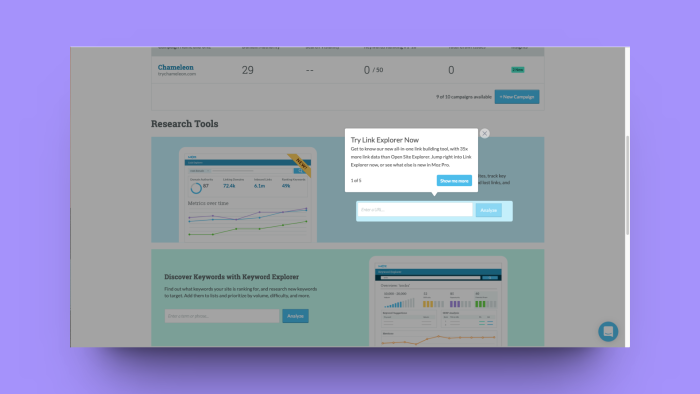
So where does sales-led fit in all this? #
First, to clear any misconceptions, product-led does not make sales-led redundant, far from it, the priorities just need to shift. When you implement product-led sales—which we’re about to get into the “how” of—your sales-led approach can shift to other areas of the business.
Perfect for upselling or cross-selling new features #
A fun fact you may already be familiar with: the success rate of selling to a current customer is between 60-70% while trying to sell to a new customer sits between 5-20%. A sales-led approach to upselling and cross-selling makes more sense for your team, you’re setting them up for success, and they’re able to deliver on these strategies by offering hyper-personalized solutions for current users.
Great for supporting enterprise accounts #
Not all accounts are going to require an account manager—and that’s okay, your business wouldn’t be scalable if you gave every user a dedicated support person.
For all of the self-serve touchpoints you have in place, some users are going to warrant an account manager for the sheer scale and complexity of their account. If you’re dealing with enterprise companies, this service will often be expected with their contract.
Enterprise accounts are a fantastic area for you to implement a sales-led approach.
Useful with customer success and customer support teams #
Lastly, where would our support and success strategies be without our people? Sales-led approaches need to be implemented among these teams. Your people can be viewed as separate from your tech—and that’s a good thing. If someone views your success or support teams as part of the problem, they’ll churn.
However, if someone views your people as separate from your solution, and able to be the success maker or solution provider, then they’re more likely to stick with you, troubleshoot, and continue on their journey within your product afterward (extending your CLTV).
This is especially the case for support teams. It’s always a good idea to offer troubleshooters the opportunity to connect with an agent if your knowledge base is not providing them with the support they’re looking for.
For example, at the bottom of the Chameleon support articles we hold a multiple choice micro-survey, asking people if we managed to answer their question(s) with the article. If they click no, the chat window pops up giving them instant access to reach out to our team to troubleshoot further.
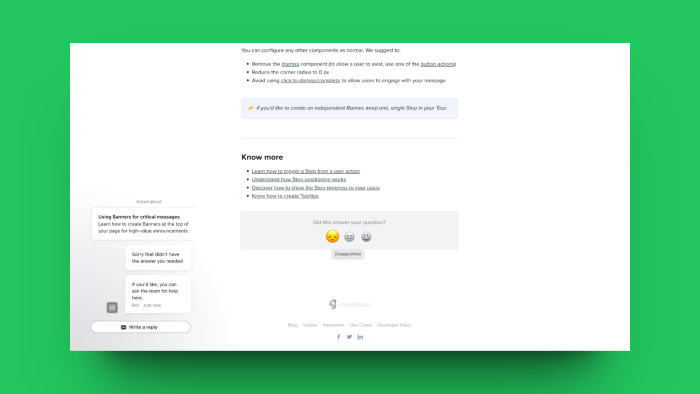
How to implement product-led sales #
Right! Let’s get into the nitty-gritty of implementing product-led sales. You can run this implementation by focusing on two things. Your people, and your flows. Let’s explore the pair.
Identify areas in your flow to introduce product-led sales #
By this point in the article, it should be pretty clear that your product-led sales approach isn’t the be-all and end-all of your sales process. What you’ll need to do is identify which areas of your acquisition strategies are likely to benefit from being product-led and which areas are best left to the humans.
A few things to consider here are:
Lead source: PPC, social media, SEO, outbound marketing, etc
CLTV: customer lifetime value depending on contract size (SMBs, enterprise, etc)
Onboarding: what can your product handle and what needs a human touch?
Upselling/cross-selling: natural opportunities for your team to dive into current accounts
Freemium vs free trial: depending on what you’re offering will present different moments to introduce people and sales tactics
Drop-off points: are there any gaps in your sales flow where you’re losing people? Would these gaps be closed with human support?
Resources & budget: what talent do you have available? Different strategies will require different people and tools (video, onboarding documents & knowledge hubs, sales people, email tools, onboarding tools, etc)
Roadmap: what can you do now, and what can you do later? What’s a high-value, must-have opportunity, and what can be bumped in the priorities list as a nice-to-have?
Educate your sales team to have a product-led approach #
Your customer success team and sales team are crucial in providing a smooth transition from sales-led to product-led comms for current users. Ensure every sales rep has a script and process in place to offboard any customer accounts that will qualify to shift toward product-led comms. It’s a critical moment in which you’ll need to work hard to combat churn.
At the same time, now’s an important moment to identify new KPIs and goals for your salespeople. Sales teams are often commission-based. So, if their direct priorities are no longer selling sign-ups, what new goals do you need to put in place to keep your talent motivated?
Want to learn more about how to integrate sales into your product-led motion? Watch out webinar below:
🎥 Learn more about building product-led sales motions
In this webinar, we’ll show you how to integrate your product-led sales and growth motions. You’ll learn how to use the right mix of strategy, tech, and data to deliver a seamless experience for the customer that helps drive revenue.
3 Product-led sales inspirations #
Product-led businesses are constantly finding innovative ways to thread product-led sales strategies into their traditional sales models. Let’s take a look.
1. Chameleon’s sales-touch assistance modal #
There’s a beautiful, happy medium to help you increase trial conversions with sales-touch assistance. Trigger sales-assisted conversations when a user’s free trial is nearing the end of its term with a timely in-app modal or pop-up.
Sometimes users are ready to make the jump to a paying account, and sometimes all they need is a nudge in the right direction from a friendly face. Either way, a sales-touch to your free trials is a fantastic way to help you boost conversion rates.
2. TravelPerk’s free-for-life plan #
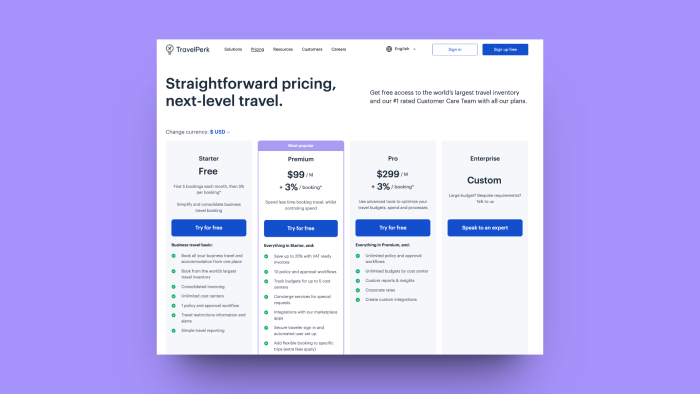
Free-for-life plans are a spectacular way to entice users into your product and get them to realize value fast. TravelPerk has managed to build a free plan that leads into a paid plan if a user starts benefiting from the platform above a designated amount.
This is also known as usage-based pricing and is becoming more common among product-led companies. The idea is to offer a usage-based free trial that users can’t help but love. They have a threshold of free use before being charged for usage after that threshold—effortlessly shifting freemium users to paying users, minus all of the direct sales.
3. Uxcel’s upsell banner and AI-assisted chatbot #
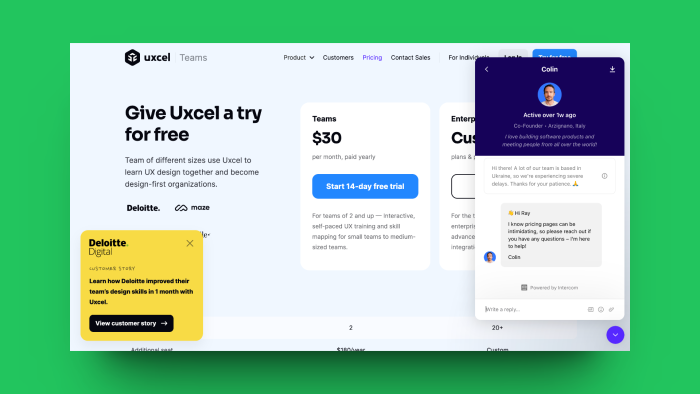
The Uxcel pricing page is a great example of how you can still run scalable sales-led efforts, without them needing to rely primarily on humans. Chatbots have come a long way, and with recent evolvements in AI, they’re smarter than ever. As long as your chatbots manage expectations from hello, you’ll continue to support potential users rather than frustrate them.
In the screenshot below, Uxcel relies on an in-product banner for its upselling opportunity—proving that even upsells and cross-sells (done right) can be product-led and automated.
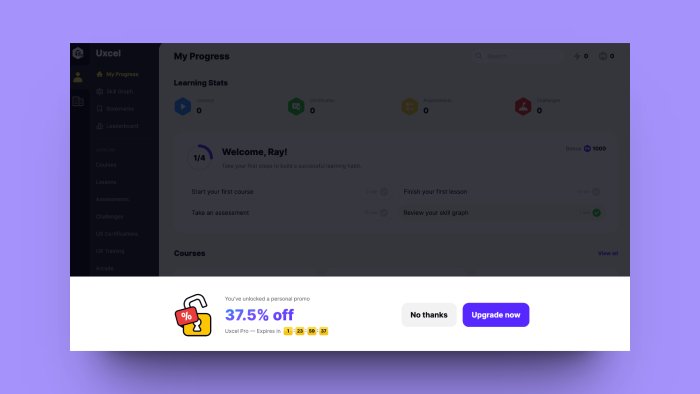
Start your own product-led sales strategy! #
Hopefully, this article has shined some light on how you can integrate a healthy blend of product-led and sales-led communication strategies to grow your SaaS business. Now, it’s time to get your own going!
Remember, a product-led growth model is not the only answer, nor is it the must-do for guaranteed user acquisition. And as much as product-led strategies are effective in driving user engagement, your sales teams have a vital role to play in getting prospective customers over the finish line.
The key takeaway? Successful product-led growth will require you to find moments in your sales flows to implement slices from both pies. Give your customers every flavor, learn from their response, and then feed them more of what they love! Let us know how you get on.
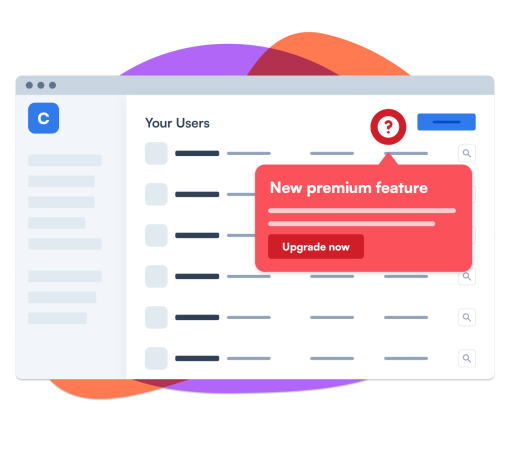
Launch your own product-led sales strategy in minutes
Easily create in-app experiences that will boost your product-led sales efforts. Try for free.




